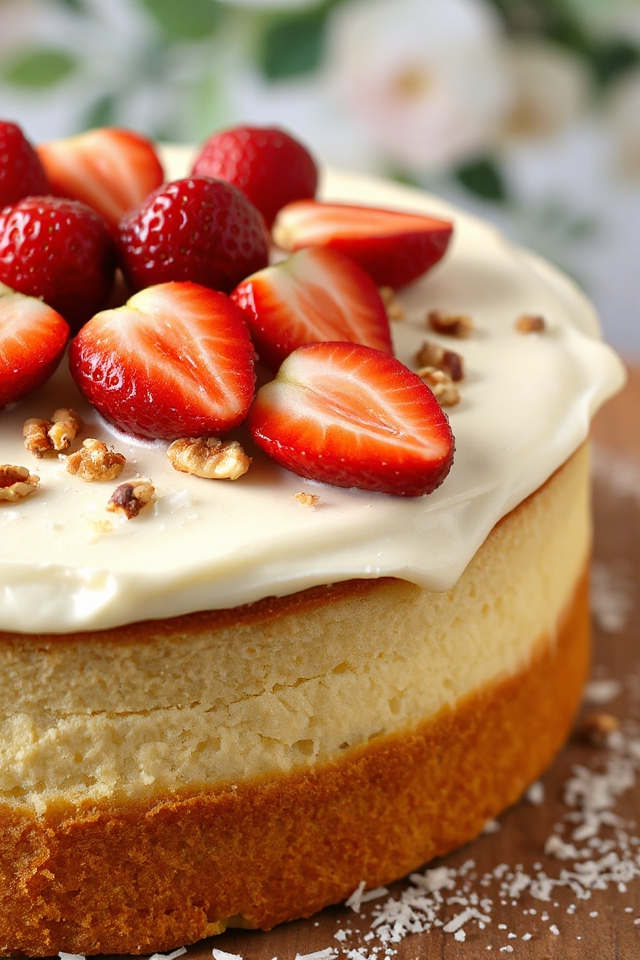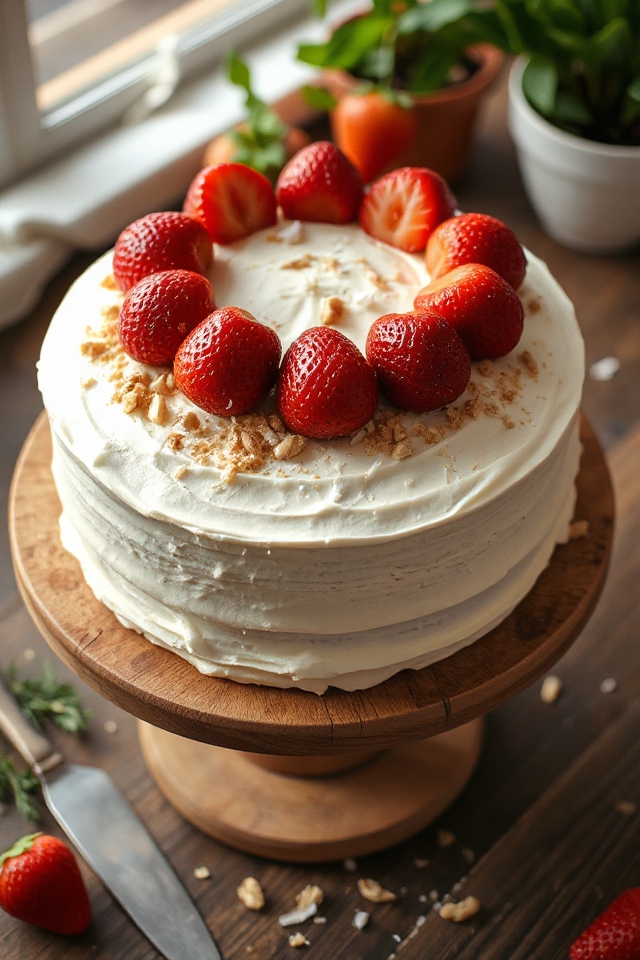Why You’ll Love this Vegan Vanilla Cake Recipe
When you take a bite of this Vegan Vanilla Cake, you’ll quickly understand why it’s a favorite. The moist, fluffy texture combined with the rich vanilla flavor creates an irresistible experience.
I love how the cake isn’t overly sweet, making each slice a perfect treat for any occasion. Plus, it’s super easy to whip up, even for those new to baking.
I appreciate that it’s vegan, so I can share it with friends who’ve dietary restrictions without sacrificing taste. Trust me, once you try it, you’ll want to make this cake again and again!
Ingredients of Vegan Vanilla Cake
When it comes to baking, the right ingredients make all the difference, especially in a delightful Vegan Vanilla Cake. This cake isn’t only a crowd-pleaser, but it also checks all the boxes for a sweet treat that’s light on the conscience.
Whether you’re vegan or just looking to try something new, this cake is a fantastic option. Plus, gathering the ingredients is an adventure in itself—who knew baking could be so colorful and fun? Let’s explore what you’ll need to whip up this deliciousness.
Ingredients for Vegan Vanilla Cake:
- 1 3/4 cups all-purpose flour
- 1 cup sugar
- 1/4 teaspoon sea salt
- 1 cup soymilk
- 2 teaspoons vanilla extract
- 1/3 cup olive oil (or any vegetable oil)
- 1 tablespoon lemon juice
- 2 tablespoons coconut oil (or spray, for greasing the pan)
- 2 cups powdered sugar (for frosting)
- 1 1/2 tablespoons vegan butter (for frosting)
- 2 tablespoons soymilk (for frosting)
- 1 teaspoon vanilla extract (for frosting)
- 3 cups fresh strawberries (cut in quarters, for topping)
- 3/4 cup walnuts (for topping)
- 1/4 cup shredded coconut (for topping)
Now, let’s chat about these ingredients a bit. You might be wondering, “Can I substitute something if I don’t have it?” and the answer is usually yes!
For example, if you’re not a fan of olive oil, any vegetable oil will do just fine. And if you’re allergic to walnuts or simply don’t have any on hand, feel free to skip them or swap them out for your nut of choice.
The same goes for the frosting—if you need a nut-free option, you can use a dairy-free margarine instead of vegan butter. The beauty of baking is that it can be flexible, just like my attempts at yoga.
How to Make Vegan Vanilla Cake

Making a Vegan Vanilla Cake is like a delightful journey, and trust me, it’s easier than you might think. First things first, preheat your oven to 350 degrees. This step is essential because we want our cake to bake evenly and come out fluffy.
While the oven warms up, grab a mixing bowl and sift together 1 3/4 cups of all-purpose flour, 1 cup of sugar, and just a pinch—1/4 teaspoon—of sea salt. Now, it’s time to add some wet ingredients: pour in 1 cup of soymilk, add 2 teaspoons of vanilla extract, and drizzle in 1/3 cup of olive oil. I like to whisk these ingredients together until they’re combined and smooth; think of it as creating a beautiful liquid canvas for your cake.
Once your batter is ready, it’s time to prepare the cake pan. Grease it with 2 tablespoons of coconut oil or a quick spray of cooking spray. This will help our cake slide out effortlessly once it’s done baking.
Pour the batter into the pan and pop it into the oven for about 30 minutes. Now, here’s a little tip: while you wait, you can clean up, but keep an eye on the oven. You want to test your cake with a toothpick; if it comes out clean, your cake is ready. Once it’s done, let it cool in the pan for a bit before transferring it to a wire rack.
Now, let’s talk frosting because what’s a cake without frosting? In a separate bowl, mix 2 cups of powdered sugar, 1 1/2 tablespoons of vegan butter, 1 teaspoon of vanilla extract, and 2 tablespoons of soymilk until it reaches a creamy, spreadable consistency. If it’s too thick, add a splash more soy milk; if it’s too thin, add more powdered sugar.
Once your cake has cooled completely—no one likes a melted mess—spread the frosting generously on top. But wait, we’re not done yet! Grind up 3/4 cup of walnuts in a food processor to your desired texture and sprinkle them on top along with a bit of shredded coconut.
And just before serving, crown your creation with 3 cups of fresh strawberries, cut into quarters. There you have it, a stunning Vegan Vanilla Cake that’s sure to impress all your friends and family, even if you accidentally forgot to set a timer or two. Enjoy every delicious bite!
Vegan Vanilla Cake Substitutions & Variations
While I love the classic flavor of a Vegan Vanilla Cake, experimenting with substitutions and variations can take your baking to a whole new level.
For a gluten-free option, swap the all-purpose flour for a gluten-free blend. You can replace soy milk with almond or oat milk for a different flavor profile.
If you want a richer cake, try adding a tablespoon of nut butter. For a fun twist, mix in citrus zest or spices like cinnamon.
And don’t forget to play around with toppings—fresh berries, crushed nuts, or dark chocolate chips can elevate your cake to new heights!
What to Serve with Vegan Vanilla Cake
After experimenting with substitutions and variations for your Vegan Vanilla Cake, it’s time to think about what to serve alongside it.
I love pairing my cake with a scoop of dairy-free vanilla ice cream; it adds a delightful creaminess. Fresh berries, like raspberries or blueberries, provide a burst of flavor and color that complements the cake beautifully.
A drizzle of homemade berry sauce can elevate the dessert even further. If you want something crunchy, roasted nuts work great as a topping.
Finally, a steaming cup of herbal tea or coffee makes for the perfect beverage to enjoy with your cake.
Additional Tips & Notes
When baking your Vegan Vanilla Cake, remember that ingredient quality makes a difference. I always recommend using fresh ingredients, especially the soy milk and vanilla extract, as they enhance the cake’s flavor.
If you want a more decadent touch, try adding a splash of almond extract. For a lighter cake, don’t skip the lemon juice; it reacts with the baking soda, creating a fluffy texture.
Finally, allow your cake to cool completely before frosting; this prevents the frosting from melting. Enjoy experimenting with toppings—fresh fruits or nuts can elevate your cake to a whole new level!
Happy baking!
